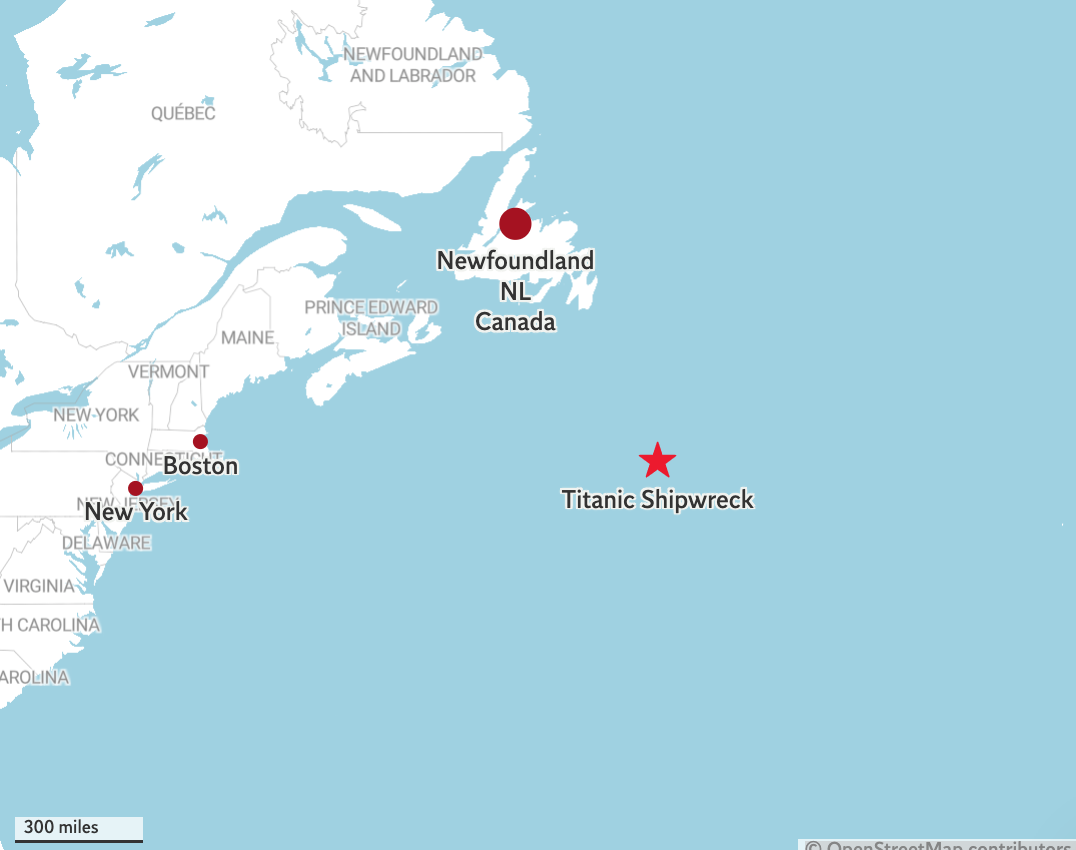Where is the Titanic wreck – and how far down is it?
The wreck’s location is approximately 370 miles off the coast of Newfoundland in the North Atlantic Ocean
Your support helps us to tell the story
From reproductive rights to climate change to Big Tech, The Independent is on the ground when the story is developing. Whether it's investigating the financials of Elon Musk's pro-Trump PAC or producing our latest documentary, 'The A Word', which shines a light on the American women fighting for reproductive rights, we know how important it is to parse out the facts from the messaging.
At such a critical moment in US history, we need reporters on the ground. Your donation allows us to keep sending journalists to speak to both sides of the story.
The Independent is trusted by Americans across the entire political spectrum. And unlike many other quality news outlets, we choose not to lock Americans out of our reporting and analysis with paywalls. We believe quality journalism should be available to everyone, paid for by those who can afford it.
Your support makes all the difference.Five crew members are confirmed to have died after the Titanic tourist submarine they were travelling in to see the site of the wreckage suffered a “catastrophic explosion,” officials said.
The OceanGate Expeditions sub went missing on Sunday after losing contact with its mothership an hour and 45 minutes into the journey. Four days later, the US Coast Guard confirmed the vessel had imploded and the people on board were believed dead.
The US Coast Guard offered its “deepest condolences” to the families after the tail cone of the submersible was found around 1,600ft from the bow of the Titanic wreckage.
OceanGate Expeditions founder and CEO Stockton Rush, British billionaire Hamish Harding, renowned French diver Paul-Henri Nargeolet, Pakistani businessman Shahzada Dawood and his 19-year-old son Suleman were all aboard the Titan.
The operator of the submersible, OceanGate Expeditions, takes paying tourists to visit the site of the infamous ocean liner.
Where is the Titanic wreckage?
The RMS Titanic's final resting spot is approximately 370 miles off the coast of Newfoundland, Canada in the North Atlantic Ocean. It sank in 1912, killing approximately 1,500 people on board. Its coordinates are 41º43’32”N, 49º56’49”W.
The wreckage was discovered in 1985 and named a UNESCO World Heritage site in 2012. Since its discovery — and thanks in part to James Cameron's iconic film about the ship's final hours — the ship and its fate have captured the public's imagination.
Why did the Titanic sink and how many people died?
The ship famously began to sink after it struck an iceberg just before midnight during its maiden voyage. The collision caused a dent in the ship’s submerged hull, which then caused its seams to buckle. Five of its interior compartments flooded, dooming the ship.
The ship sank for hours, but it only carried enough lifeboats to evacuate approximately half of the passengers. Shortly after 2am, the ship’s sinking accelerated as its deck dipped below the waterline. The ship’s stern rose out of the water, exposing the propeller, and then snapped in half. Its stern remained nearly vertical for several minutes before it crashed back to the waves and sunk.
Many of the passengers and crew who fell into the icy waters died within minutes due to cardiac arrest due to cold exposure or drowning. A total of 1,500 passengers died.
The list of weathy and notable passengers who died on the ship helped to secure the Titanic’s place in history. Among the dead was John Jacob Astor IV, who was believed to be among the richest men in the world at the time he died. His net worth was estimated to be $87m, which would be the equivalent of $2.4bn in 2022.
The ship’s wreckage eventually settled on the ocean floor approximately 12,500 feet — or 3,800 m — below the surface.
How long did it take to find the Titanic?
The Titanic wreckage was discovered 73 years after it sank, in 1985, when the first underwater images were transmitted back to researchers.
The ship was found after eight days of searching, and was located by a joint French–American expedition led by Jean-Louis Michel and Robert Ballard.
In 2012, the wreckage became a UNESCO World Heritage site.
Despite the offerings of a chance to see the wreckage, very few people have actually taken the journey to the ship’s remains. Only 250 people have ever visited, as an eight-day diving tour costs approximately $250,000 per guest, according to the OceanGate website.
Researchers and tourists may be in a rush to visit the site, as experts believe that the quickly eroding remains may be fully lost by the year 2030. Current research at the site is barred from removing or disturbing the remains at the site.
OceanGate Expeditions’ Titan submersible was thought to be capable of extremely deep dive expeditions, including those to visit the Titanic wreckage and carry enough life support equipment to keep a crew of five alive for up to 96 hours, according to its website.
It is unclear when or where the Titan imploded though the Coast Guard said sonar buoys would have likely picked up the sound if they had been in place.

In a statement, OceanGate Inc said: “Our hearts are with these five souls and every member of their families during this tragic time. We grieve the loss of life and joy they brought to everyone they knew.”
“These men were true explorers who shared a distinct spirit of adventure, and a deep passion for exploring and protecting the world’s oceans.”




Join our commenting forum
Join thought-provoking conversations, follow other Independent readers and see their replies
Comments